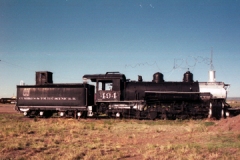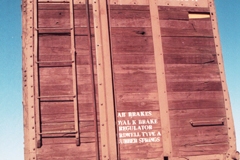While I was there they were in the off/maintenance season, when the train isn’t running, so they let me roam around the yard. They were doing minimal work at the time.
Here’s their website – http://cumbrestoltec.com/
ALL ABOARD!
Experience the excitement of rugged, narrow gauge, coal-fired, steam powered mountain railroading on the Cumbres and Toltec Scenic Railroad. You will traverse 64 miles of unparalleled scenery as you climb from Antonito or Chama to the dining hall at Osier and on to your final terminal. Lunch is included of course. You will sense the grandeur of the Rocky Mountains as your train is handled by sure-footed locomotives and able crews through tunnels, above deep gorges and over Cumbres Pass. This unique section of mountain railroad is owned by the states of New Mexico and Colorado and was designated a National Historic Landmark in October of 2012. It is truly a memorable experience not to be missed.
Cumbres & Toltec Scenic Railroad was awarded the Natinal Historic Landmark Designation 2013. America’s most authentic steam-operated railroad, the Cumbres & Toltec is a proud remnant of the spirit that won the West. Built in 1880, it was part of the San Juan Extension of the Denver & Rio Grande Railroad, with tracks running from Denver through the ore-rich Rocky Mountains to Silverton, Colorado and Santa Fe, New Mexico. Its path through steep passes and deep gorges is the stuff of adventure novels and was an engineering feat for the time. The decline of silver mining in the 1890s ended the railroad’s vital role. It was abandoned in 1969, but the most scenic part of its route, its equipment, and its buildings were saved. Today the Cumbres & Toltec Scenic Railroad fulfills another important mission – taking passengers on the ride of a lifetime.
Here’s a big piece of background from WikiPedia:
The Cumbres & Toltec Scenic Railroad (C&TS) is a narrow gauge heritage railroad running between Chama, New Mexico and Antonito, Colorado. It runs over 10,015 ft (3,053 m) Cumbres Pass and through Toltec Gorge, from which it takes its name. Trains operate from both endpoints and meet at the midpoint.
History
Construction
The railroad line was originally constructed in 1880-1881 by the Denver and Rio Grande Railroad as part of their San Juan Extension stretching from Alamosa, Colorado to Antonito, Colorado. The line was constructed with 3′ gauge track to match the D&RG’s other lines. The line primarily supported mining operations in the San Juan mountains, mainly around Durango and Silverton. Today’s Durango and Silverton Narrow Gauge Railroad was built in 1882 as a branch line off this main. By the late 1950s mining had dwindled substantially and the line was on the verge of abandonment, but an oil boom near Farmington, New Mexico created a traffic surge that kept the line operating for another decade hauling oil and pipe. By the late 1960s the traffic was virtually gone and abandonment was applied for.
Tourist operations[edit]
In 1970, the states of Colorado and New Mexico jointly purchased the portion of the line from Antonito, Colorado to Chama, NM, along with much of the equipment that operated on the line. This section is the most scenic portion of the line, and a part that loops back and forth between the two states. The Cumbres and Toltec Scenic Railroad Commission was created by an act of Congress as a bi-state entity to oversee the railroad.
Over the years the railroad has been operated by several operators under contract by the commission, including Scenic Railways (1970-1981), Kyle Railways (1982-1996), Cumbres and Toltec Scenic Corporation/George Bartholomew (1997-1999), Rio Grande Railroad Preservation Corporation (2000-2002), Cumbres and Toltec Scenic Management Corporation (2003-2011), American Heritage Railways (2012) and Cumbres and Toltec Operating LLC (2013-).
1999 Operator Change[edit]
the lease of operator Cumbres and Toltec Scenic Corporation (George Bartholomew) was terminated by commission due to a failure to properly maintain the railroad and its equipment, replenish used parts and making rent payments.[2] Rio Grande Railroad Preservation Corporation, formed by the Friends of the Cumbres and Toltec, assumed operations of the railroad a few months later.
2002 FRA Shutdown[edit]
In spring 2002 the Federal Railroad Administration ordered the shutdown of the shutdown of the railroad until specific track bed issues were resolved.
2002 Forest Fire Shutdown
The railroad was closed for much of the summer of 2002 by the US Forest Service due to extremely dry conditions, forest fires across the region, and fears that the steam locomotives would cause fires.
2010 Trestle Fire
On June 23, 2010, a brush fire severely damaged the Lobato Trestle, a long and high deck girder bridge. The railway trucked locomotive 484 and some coaches from Chama to Cumbres so that operations could continue on both sides of the break.
As of Monday, June 20, 2011, the Lobato Trestle was returned to service, and trains were once more traveling the full length of the railroad, from Chama, New Mexico to the summit of Cumbres Pass and beyond, all the way to Antonito, Colorado. This includes the daily lunch stop at Osier.
2012 Operator Change[edit]
In 2012 the Cumbres and Toltec signed a contract with American Heritage Railways to operate the railway; AHR also owns the Durango & Silverton Narrow Gauge Railroad and the Great Smoky Mountains Railroad, and formerly was operator of the Texas State Railroad. AHR gave notice at the end of the 2012 season that they would withdraw as operator. The C&TS formed a special sub-entity, Cumbres & Toltec Operating LLC, to operate the railway after AHR pulled out. John Bush was hired as president of C&TO in December 2012.[5]
Tourist Train Ride[edit]
Trains depart each morning from both Chama, New Mexico and Antonito, Colorado. In peak season there are trains every day of the week in either direction. The meet an Osier, the midpoint of the line where lunch is provided. Passengers may continue on their train to the other end, or switch trains to return to their original terminal. Through riders have the option of a motor coach return to their original terminal. All seats are reserved. Seats are sometimes available to walk-ups, but this is rare in peak season.
The railroad provides standard seats in coaches, or first class seats in a parlor car. An gondola with no seats is usually provided for standard or first class riders who prefer to ride in the open air after their ticket is taken. A concession car with snacks and gifts is on each train and bathrooms are available on the train.
All passenger trains are pulled by historic steam locomotives that originally worked on this line and others of the Denver and Rio Grande Western. Heavy trains out of Chama may have two locomotives as far as Cumbres Pass. East bound from Chama is the steepest portion so the steam engines tend to work hard and give off an acoustic and visual show. The remaining 3/4 of the eastbound trip is downgrade and the locomotives are fairly quiet. Westbound from Antonito, the grade is much less but the locomotives periodically work harder, especially on the last couple miles to Cumbres Pass.
The line passes through Rio Grande and Carson National Forests. Most of the line is bordered by rocky ledges, cliffs and formations of varying types. The train passes along the rim of Toltec Gorge, a spectacular, though brief highlight. Conifer and aspen trees dominate with periodic mountain meadows. The aspen trees turn a brilliant yellow in the fall making those trips popular. The easternmost quarter shifts to scrubby and arid rolling hills. There are numerous restored historic structures along the line, including two tunnels, bridges, section houses and water tanks.
Car and train charters are available. Extensive historic equipment is available for chartering.
There
The Cumbres and Toltec is highly regarded by both railfans and historians due to its relative authenticity and surviving historic fabric. Chama houses one of the most physically complete railroad yards from the steam era in the US. Although portions of the roundhouse, warehouses, and parking lots have been changed, the railroad yard has the ambiance of pre-1960 railroad operations. The yard tracks contain authentic rolling stock and structures of the Denver and Rio Grande indigenous to the railroad line.
All the steam locomotives at the C&TS were built for and operated their entire careers for the Denver and Rio Grande Western. All 2-8-2 Mikados, these range from the relatively small K-27 “Mudhen”, #463, once owned by Gene Autry, to the large K-37s, originally built as standard gauge locomotives. The mainstays are the venerable K-36 fleet, produced by Baldwin Locomotive Works in 1925. The only two Surviving D&RGW rotary snowplows are onsite and both have operated for the C&TS.
As Denver & Rio Grande Railroad San Juan Extension, the railway was listed on the National Register of Historic Places in 1973. The boundaries of the NRHP listed area were increased in 2007.[1]
The railroad was featured extensively in the 1969 film The Good Guys and the Bad Guys, and was used in the opening sequence of “Indiana Jones and the Last Crusade”.
Railroad Operations[edit]
The C&TS is 64 miles (103 km) in length with numerous siding and yards. There are turning wyes at Chama, Cumbres and Bighorn, turning loops at Osier and Antonito and a crossover at Lava. While officially headquartered in Chama, the railroad splits most of its functions between the terminuses of the railroad. The Cumbres and Toltec Commission offices are at Antonito, along with the railroad’s main car shop where repairs to rolling stock are performed. The center of actual operations for the railroad is Chama, the site of the locomotive repair shop and the location of most of the historic equipment.
Line Description
Beginning in Chama (Milepost 344.12), the railroad makes a nearly straight shot northeast after leaving the yard and crossing the Rio Chama (Rio Grande). About a mile later begins a 4% grade which is nearly constant from there to Cumbres. with the exception of a stretch at Coxo. The first siding on the line is located at Lobato (MP: 339.99), located here are the remnants of a stock pen, and a water tank specifically made for a movie in the 1970s. The tank was used later in Indiana Jones and the Last Crusade. The water tank was knocked over in 2006, due to age and high winds. Just under a quarter of a mile away, is Lobato Trestle, the second highest trestle on the line, built in 1883. Due to weight restrictions, only one locomotive at a time is allowed to cross; therefore, all double-headers must separate, and rejoin on the other side. On June 23, 2010, a BIG fire of unknown origin burned the Loboto Trestle destroying the wooden deck and railroad crossties. This fire also caused unrepairable damage to the bridge’s steel spans, requiring their replacement. Trains departed Cumbres instead of Chama for the rest of the 2010 season. Work to replace the bridge spans began in March 2011 and was finished in June 2011. The first passenger train over the bridge occurred on the morning on June 18, 2011.
From here to Cumbres, the railroad operates on the north side of Wolf Creek. On the journey to the top at Cumbres, the train passes Cresco Siding and water tank (MP 335.10) and navigates a small canyon past Hamilton’s Point. Exiting the canyon, the track makes a turn to the northwest and up the Wolf Creek drainage through Coxo. At a narrow point of the valley, the track makes a horseshoe turn up to Windy Point, which the train rounds to enter Cumbres Pass.
At Cumbres (MP 330.48), elevation 10,015 ft (3,053 m), is the Car Inspector’s House, Water Standpipe, remnants of the extensive snow shed, and the Section House, which replaced the original depot after it was demolished in the 1950s. Cumbres is the highest point on the railroad. From here east, the track heads down at 2.5%, and descends the Cumbres Loop, more commonly refer to as “Tanglefoot Curve”. After exiting the loop, the track follows a general easterly direction until Milepost 327.6, where they turn north up the Los Pinos Valley.
Heading north, the track loses elevation, while the valley slopes up, with the track and valley floor finally meeting at Mile 325, where the track once again changes direction, heading south on the other side of the valley, following the Rio de Los Pinos toward Osier. After Mile 323, the track again leaves the valley, on a much steeper grade, while the track clings to the valley created by the river. Along the way, the track crosses Cascade Trestle (MP 319.95), taller than the Lobato Trestle, at 137 ft (42 m). Approximately a mile and a half later, the track enters Osier, Colorado, the midpoint of the railroad where the two trains meet for lunch. Here, riders may switch trains and return to their point of origin, or ride to the opposing terminus.
Antonito to Osier[edit]
C&TS steam locomotive #484
This section covers the eastern portion of the line from the small cattle and junction town of Antonito to Osier, the midpoint of the line.
Antonito (MP 280.70) is a small company town of the former railroad main line. It is home to the C&TS car shop, a water tank, and other relics. Most of the facilities were built by the Cumbres & Toltec, as the original rail yard, wye, and station were not sold to the states of Colorado and New Mexico.
Shortly after leaving the station, the train heads straight for 3 miles (4.8 km), until coming into some hills. Shortly thereafter, the train crosses Ferguson’s Trestle (MP 285.87), named for a man who was hung from a locomotive there. The original trestle was featured in the 1988 TV movie Where The Hell’s That Gold? starring Willie Nelson and Delta Burke. In filming, a planned explosion ended up getting out of hand and the bridge was burned down. Traffic was halted for a week while the C&TS built a temporary bridge; the following winter it rebuilt the trestle to match the original. About three miles (5 km) later, the train makes the first of 11 crossings into New Mexico, and climbs a ledge up to a lava mesa. Lava (291.55) has the old water tank from Antonito which was moved here in 1971. The track goes around a horseshoe curve which is also used as a reversing loop to turn the rotary snow plow trains from Chama. The Cumbres and Toltec has two rotary snowplows, Rotary OM and Rotary OY.
Heading west, the track rounds Whiplash Curve, a double horseshoe curve. About a mile from Whiplash Curve lie the sidings and wye at Big Horn. Past Big Horn the train loops around the sides of mountains going through horseshoe curves before reaching the first water stop at Sublette.
Sublette is an abandoned railroad section camp, consisting of a log bunk house, a section house, a siding, and other buildings. There used to be a water tank at the western end of the siding, but today, in its place, is a standpipe. After filling the tender with water, the engine and the train slowly creep into lush aspen groves.
After departing Sublette comes Toltec Siding, which in the 50’s was the meeting place of long oil well pipe trains moving between Chama and Farmington to Alamosa. Shortly afterwords, trains pass through Mud Tunnel, which is unique because it is lined with wooden pillars since it is bored through soft volcanic ash. When the beams in the tunnel collapsed, the D&RGW made a “shoo fly” around the tunnel to allow passengers and small cars to be moved around the tunnel to an awaiting train. After passing through this, trains pass around Phantom Curve and through Calico Cut, and then the trains slow down as they enter the longer Rock Tunnel. Trains exit the tunnel, entering the Toltec Gorge, where the track is 600 ft (180 m) above the river. The line follows the river the remainder of the distance to Osier.










